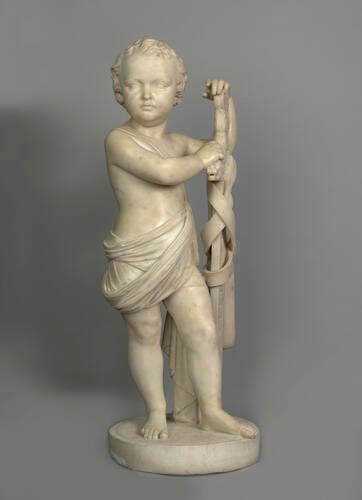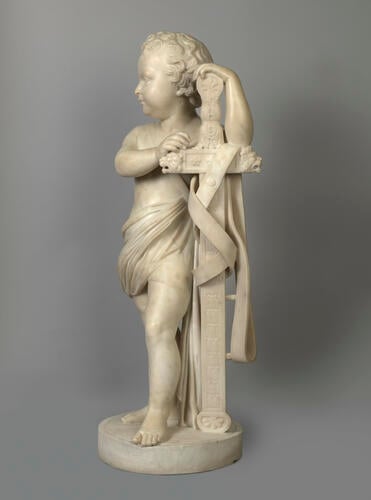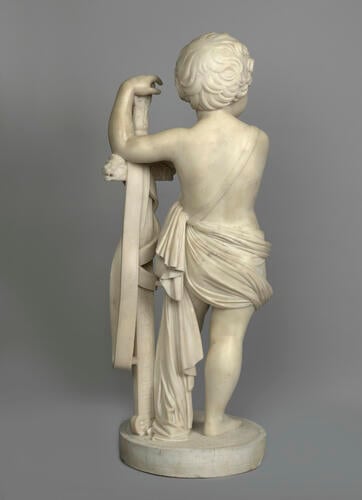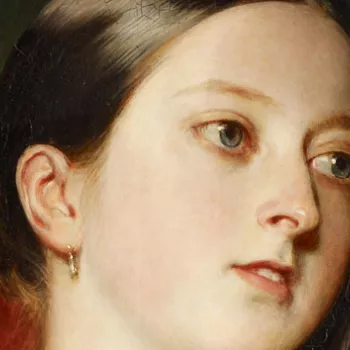Prince Arthur (1850-1942), later Duke of Connaught and Strathearn 1853
Marble | 100.9 cm (whole object) | RCIN 2076

Baron Carlo Marochetti (1805-67)
Prince Arthur (1850-1942), later Duke of Connaught and Strathearn 1853

Baron Carlo Marochetti (1805-67)
Prince Arthur (1850-1942), later Duke of Connaught and Strathearn 1853

Baron Carlo Marochetti (1805-67)
Prince Arthur (1850-1942), later Duke of Connaught and Strathearn 1853




-
Full length marble statue of Prince Arthur aged three, standing partially draped and leaning on a full-size classical sword, looking to his right.
As the family of the Queen and Prince Albert steadily grew in number during the 1840s and early 1850s, sculptors were no less involved than artists in other media in the difficult business of recording infant likenesses. This little-known portrait of the 3-year-old Prince Arthur, their third son, is among the most successful, combining charm with dignity whilst avoiding sentimentality.
The Piedmontese sculptor Carlo Marochetti had established himself in Paris with a clientele including several members of the royal family before the Revolution of 1848 drove him abroad, with so many other artists. He lost no time in achieving his first English royal commission, a bust of Prince Albert. During the sittings the Queen formed the opinion that the Baron was 'very agreeable, pleasing & gentlemanlike', and a succession of further commissions followed.
In this statue, which was placed in the ground floor corridor at Osborne dedicated chiefly to ancient and neoclassical marble sculpture Prince Arthur's unusual pose recalls representations of the Infant Christ with the Cross. The substitution of the sword in this otherwise portentous iconography refers to the Prince's recently deceased godfather, the Duke of Wellington (1769-1852), whose Christian name and birthday (1 May) he shared, implying that the Prince, whom Queen Victoria came to regard as her favourite son, had inherited the trappings - and the valour - of the warrior Duke. A point of reference for this Christian interpretation is Winterhalter's painting The First of May 1851, in which the Duke of Wellington plays his part in a composition resembling the Adoration of the Magi.
In June 1853, when Marochetti professed himself 'very proud' of the statue, he must have been referring to his clay model, for it was not until a year later that the Queen was able to record in her Journal ‘Marochetti's statue, in marble, of dear little Arthur, has arrived & is beautiful.’ Queen Victoria ordered reductions of the figure in bronze, plaster and alabaster to present as gifts. The statue was also reproduced in Parian ware by Minton.
At the age of five Prince Arthur was taken to Horse Guards Parade to watch his mother distribute Crimea medals, the first occasion on which a sovereign decorated not only officers but other ranks. The experience is said to have made an indelible impression on him. A career soldier, he rose to the rank of field marshal in 1902.
Text from Victoria & Albert: Art & Love.Provenance
Commissioned by Prince Albert (payment dated 28 August 1854, £431 10s together with two bronze busts, PA Ledgers) and presented to Queen Victoria on her birthday, 24 May 1853 (in plaster; the marble was delivered to Osborne in August 1854)
[Victoria & Albert: Art & Love, London, 2010, pg 458]
-
Creator(s)
Acquirer(s)
-
Medium and techniques
Marble
Measurements
100.9 cm (whole object)








